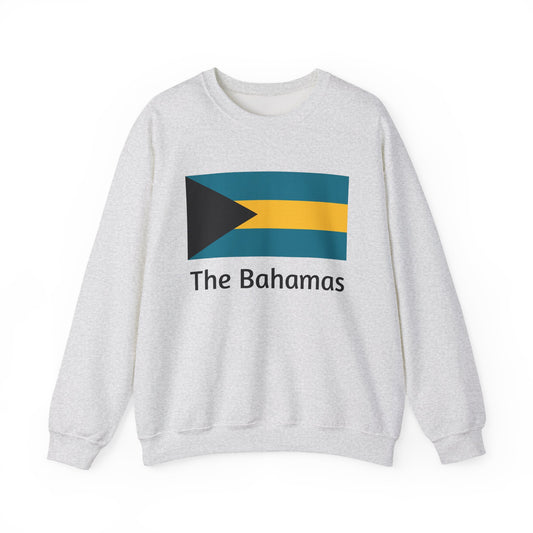-
Bahamas Flag Hoodies
Regular price $34.40 USDRegular priceUnit price / per -
The Bahamas Pillow
Regular price $22.65 USDRegular priceUnit price / per -
The Bahamas Backpack
Regular price $59.79 USDRegular priceUnit price / per -
The Bahamas Leather Patch Hat
Regular price $18.85 USDRegular priceUnit price / per -
The Bahamas Flag Sweatshirt
Regular price $34.15 USDRegular priceUnit price / per -
The Bahamas Sweatshirt
Regular price $34.15 USDRegular priceUnit price / per -
The Bahamas Mug
Regular price $11.65 USDRegular priceUnit price / per -
The Bahamas Trucker Cap
Regular price $14.90 USDRegular priceUnit price / per -
Bahamas Hoodies
Regular price $34.40 USDRegular priceUnit price / per -
Bahamas T-shirts
Regular price $22.79 USDRegular priceUnit price / per -
Bahamas Flag on T-shirt
Regular price $22.79 USDRegular priceUnit price / per
Collection: The Bahamas
The Bahamas flag symbolizes national pride and history, reflecting the rich tapestry of events and changes that have shaped the country over time. From its design and colors to its historical context and symbolism, the flag tells a story of resilience, independence, and identity. We will delve into the intricate details of the Bahamas flag, exploring its evolution, meanings, and current relevance in the modern era.
Overview of the Bahamas Flag Design and Colors

At the heart of the Bahamian identity lies its flag, a vibrant representation of the nation's essence and environmental beauty. Comprising three horizontal stripes of equal width, two aquamarines on the top and bottom, and a central gold stripe, the flag is a visual echo of the Bahamas' natural splendor. These colors are not chosen randomly; the aquamarine stripes mirror the stunning, clear waters surrounding the islands, indicative of the Bahamas' rich marine life and its people's deep connection to the sea.
The central gold stripe is a homage to the sun-drenched, sandy beaches that line the archipelago, symbolizing the land's wealth and the Bahamian people's spirit. Dominating the flag's left side is a bold black triangle pointing towards the body of the flag. This triangle stands as a symbol of unity and strength, highlighting the determination and resilience of the Bahamians. Together, these elements not only define the physical beauty of the Bahamas but also embody the vigor and ambition of its people, making the flag a potent symbol of national pride and cultural identity.
Historical Context: Adoption and Evolution
The genesis of the Bahamas flag traces back to a pivotal moment in the nation's history when it transitioned from a British colony to an independent state. Officially adopted on the significant date of July 10, 1973, the flag symbolized a new beginning for the Bahamian people, embodying their aspirations, culture, and sovereignty. The selection of the flag's design was the culmination of a nationwide effort to craft an emblem representing the newly independent country's identity and values.
Over the years, this emblem has remained unchanged, standing as a testament to the enduring spirit and unity of the Bahamas. Its introduction marked the end of an era dominated by colonial symbolism and the start of a chapter in which the Bahamians could assert their narrative and national pride. This transition heralded a new political and social landscape for the Bahamas and solidified the flag's role as a central part of the country's national consciousness.
Symbolism: The Meanings Behind the Design

The symbolism embedded in the Bahamas flag profoundly reflects the nation's identity and aspirations. The two aquamarine stripes evoke the crystal-clear waters synonymous with the islands, signifying the Bahamas' deep connection to the sea and its marine heritage. This maritime link underscores not only the geographical essence of the nation but also its economic reliance on the sea for sustenance and tourism. The central gold stripe captures the radiant sun and the expansive, sandy beaches that are a hallmark of the Bahamian landscape, symbolizing the natural wealth and beauty of the islands.
This vibrant color also reflects the optimism and warmth of the Bahamian people. The striking black triangle at the hoist side symbolizes the people's unity and determination. It points forward, suggesting the nation's collective effort and direction toward progress and a brighter future. Together, these elements weave a narrative of resilience, resourcefulness, and a deep-seated bond with the natural environment, encapsulating the spirit and enduring strength of the Bahamas and its inhabitants.
Current Relevance: The Flag in Today's Bahamas
Today, the flag of the Bahamas is a ubiquitous symbol throughout the nation, emblematic of its sovereignty and the unity of its people. It waves prominently at official government establishments and educational institutions and during pivotal national celebrations and military ceremonies, signifying the Bahamian populace's shared identity and collective spirit. Beyond its ceremonial use, the flag represents the nation on the global stage, fluttering at international conferences, sporting events, and diplomatic engagements, showcasing the Bahamas' pride and presence worldwide.
Discussions surrounding the flag's symbolism and design occasionally surface, reflecting the dynamic nature of national identity and the ongoing dialogue about what it means to be Bahamian in the contemporary world. These conversations are a testament to the flag's living relevance, indicating its role as a static symbol and an active participant in the nation's continuing story. Its presence in everyday life and moments of national importance underscores the flag's enduring significance in the hearts and minds of the Bahamian people.
Additional Facts: Protocols and Anecdotes
In observing the etiquette surrounding the Bahamas flag, established protocols emphasize its reverence and importance. Among these, the flag must be prominently displayed to ensure it is always in pristine condition, reflecting the dignity and respect it commands. Notably, it is considered a sign of disrespect for the Bahamas flag to be allowed to fall or lay on the ground. Furthermore, the flag is only to be flown at half-mast during national mourning or to mark significant, somber occasions, as directed by the government, underscoring the nation's collective sorrow or remembrance.
One particularly captivating anecdote about the Bahamas flag involves its inception; the flag was the product of a national contest that invited citizens to contribute designs that encapsulated the essence and aspirations of the Bahamian people. This initiative led to the selection of a design created by a high school student, symbolizing not only the talent and creativity of the nation's youth but also the inclusive spirit of the Bahamas in valuing contributions from all walks of life. This story highlights the collaborative effort and national pride in creating a symbol that would henceforth represent the country's identity on the world stage.
These insights into the flag's protocols and origin story enrich the narrative of the Bahamas flag, revealing the depth of meaning and respect woven into its fabric.






















